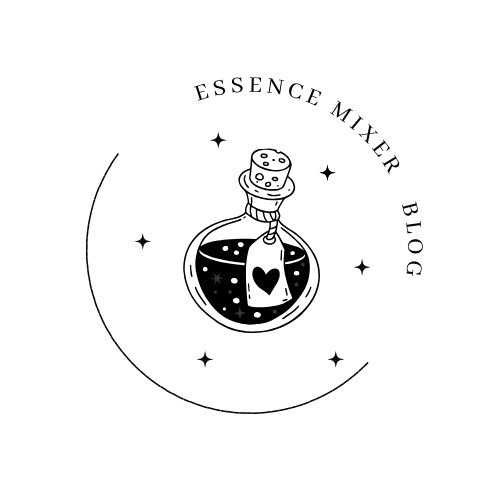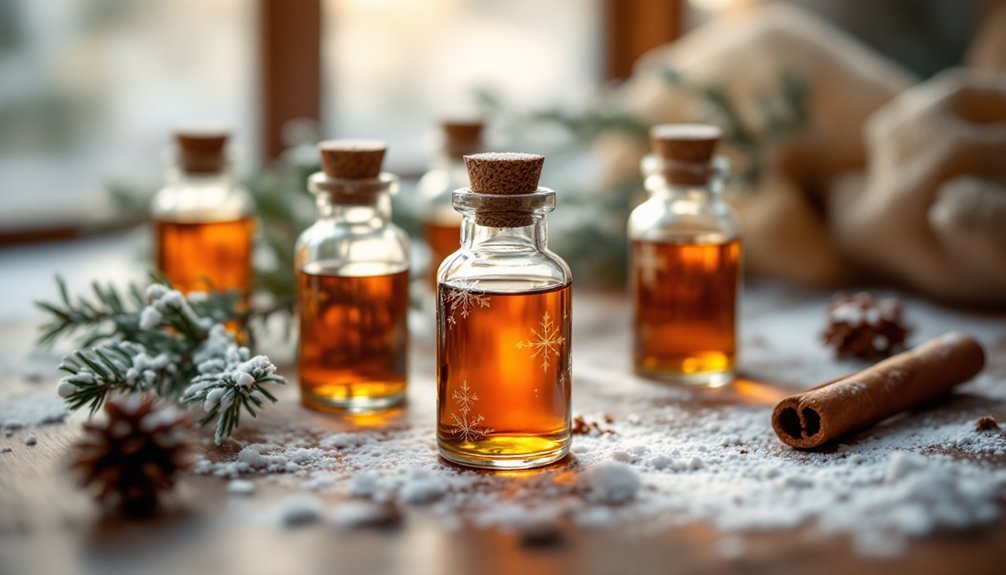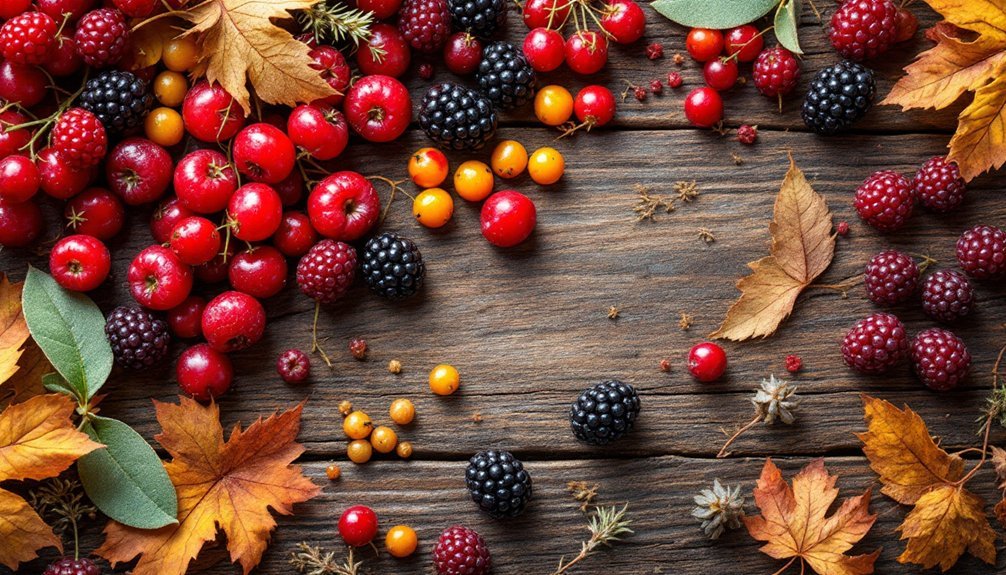To sanitize perfume bottles safely, start by gathering your supplies: dish soap, white vinegar, isopropyl alcohol, and soft brushes. Empty the bottle completely, then soak it in equal parts vinegar and warm water. Use the rice and soap method for deep cleaning by adding uncooked rice with soapy water and shaking. Rinse thoroughly, clean the spray nozzle separately, and air dry completely. Following these initial steps sets you up for a properly sanitized bottle that's ready for reuse.
Gathering Your Cleaning Supplies

A well-stocked cleaning kit is essential for properly sanitizing your perfume bottles.
Keeping your perfume bottles pristine requires a complete cleaning arsenal – it's the foundation of proper fragrance maintenance.
You'll need gentle dish soap and white vinegar as your primary cleaning agents, along with soft-bristled brushes for delicate glass surfaces. Don't forget to include lint-free cloths for drying and polishing.
For reaching inside the bottles, gather flexible swabs, long-handled cotton sticks, and nail polish remover brushes that can navigate narrow necks. Having 99% isopropyl alcohol on hand provides the most effective cleaning and residue removal.
A miniature funnel will help prevent spills during refilling. Include warm water for rinsing and organic alcohol if you need quick drying.
Consider adding specialized tools like bottle brushes for complex designs and suction tools for stubborn caps. Keep soft sponge scrubbers and dry towels handy for exterior cleaning.
Rice can serve as a gentle abrasive for tough stains.
Emptying and Initial Vinegar Soak
To save any remaining perfume, transfer it to a smaller container using a funnel before starting the cleaning process.
You'll want to mix equal parts white vinegar and warm water, creating an effective solution for breaking down fragrance residue.
Fill your empty perfume bottle with this mixture and let it soak for at least an hour, making sure to give it a gentle shake to reach all interior surfaces. Choose a clean workspace area to avoid any contamination during the cleaning process.
Initial Perfume Transfer Tips
Successfully sanitizing a perfume bottle begins with proper emptying and an initial vinegar soak.
You'll want to transfer any remaining perfume to a smaller container using a funnel or pipette to prevent waste. Store this excess fragrance in a cool, dark place to maintain its quality. Before transferring, be sure to seal the caps securely to avoid any accidental spills.
Once you've emptied the bottle, prepare a solution of white vinegar diluted with water. This mixture helps remove stubborn residues and opens up the glass pores for better sanitization.
Before soaking, disassemble all parts of the bottle – remove the sprayer, caps, and stoppers. You'll need to clean these components separately.
Don't forget to inspect the bottle's material first to verify it won't be damaged during the cleaning process. Use small brushes and cotton swabs to reach tight spaces between parts.
Vinegar Solution Best Practices
When preparing your vinegar solution for perfume bottle sanitization, mix equal parts white vinegar and warm water to create an effective cleaning agent. This natural mixture helps break down stubborn perfume residues without damaging your bottle's glass or plastic surfaces.
Before adding the solution, verify you've completely emptied the bottle and removed all sprayer components.
Pour the vinegar mixture into your perfume bottle and gently shake it to guarantee even coverage. Let the solution soak for at least an hour to effectively dissolve any remaining perfume oils.
Place the bottle on a safe surface where potential spills won't cause damage. You'll find this method both cost-effective and environmentally friendly compared to harsh chemical cleaners.
Remember to handle the bottle carefully during the soaking process.
Rice and Soap Deep Cleansing Method

Deep cleaning perfume bottles becomes effortless with the rice and soap method, which combines natural abrasives with gentle cleansers.
You'll need warm water, mild dish soap, and uncooked rice to create an effective cleaning solution that's safe for both glass and plastic bottles.
- Fill your bottle halfway with warm water and add a teaspoon each of dish soap and uncooked rice.
- Gently shake the mixture to distribute ingredients evenly throughout the bottle.
- Let the solution sit for about an hour to break down stubborn residues.
- Rinse thoroughly with warm water until all soap and rice particles are gone.
For bottles with intricate designs, use a soft-bristled brush to reach tight spots.
Once clean, air dry your bottle or pat it with a lint-free cloth before storing or reusing.
Tackling Tough Perfume Residue
Removing tough perfume residue requires a targeted approach using proven cleaning agents and techniques.
You'll find that a mixture of white vinegar and water works effectively on stubborn stains, especially in glass and crystal bottles. Before you begin, make certain your bottle is completely empty to prevent any unwanted chemical reactions.
For the most resistant residue, combine different cleaning methods. Start with a soap solution to break down oils, then use a small brush to scrub the interior surfaces.
Don't forget to pay special attention to corners and crevices where residue often accumulates. If you're dealing with plastic bottles, avoid harsh chemicals like acetone that can damage the material.
Instead, stick to gentle detergents and multiple rinses to guarantee thorough cleaning.
Proper Drying and Component Care

After thoroughly cleaning your perfume bottles, proper drying and component care become essential for maintaining their longevity and performance.
You'll want to focus on thorough drying to prevent moisture buildup, which can affect both the vessel and spray mechanism.
- Place your bottles upside down on a drying rack to guarantee proper air circulation and complete moisture evaporation.
- Use a clean, soft towel to gently wipe away visible water droplets from the exterior and spray mechanism.
- Clean the spray nozzle with lukewarm soapy water and a soft brush to remove any residue or blockages.
- Store your bottles in a cool, dark place with caps tightly secured once they're completely dry.
If you're in a hurry, you can speed up the process using a hairdryer on low heat, but avoid excessive heat exposure.
Bottle Inspection and Final Rinse
The final stages of sanitizing perfume bottles require meticulous inspection and thorough rinsing to ascertain ideal results.
Examine your bottle at a distance of 40-50 cm, checking for any scratches, nicks, or imperfections that might've occurred during cleaning. You'll want to make sure there's no residual soap or vinegar solution left inside.
Rinse your bottle thoroughly with warm water, paying special attention to the mouth and interior.
Don't forget to clean and dry the cap and sprayer separately. For stubborn residue, you can use uncooked rice as a natural abrasive to help remove any remaining oils.
Once cleaned, let your bottle air dry completely to prevent water spots.
Perform a final visual inspection under good lighting to confirm there's no damage or leftover residue before reuse.
Preparing for New Fragrance Use

Before introducing a new fragrance to your sanitized bottle, proper preparation assures ideal results and prevents cross-contamination.
You'll need to guarantee your bottle is completely dry and free from any cleaning residue before adding your new scent. Use a soft cloth to give the exterior one final polish, removing any fingerprints or smudges that might've accumulated during the cleaning process.
- Check that all components are thoroughly dried, especially in crevices and hard-to-reach areas.
- Place the bottle upside down on a clean, lint-free towel for 24 hours to eliminate any remaining moisture.
- Inspect the bottle's seals and stoppers to confirm they're in perfect condition.
- Store your prepared bottle in a cool, dry place away from direct sunlight until you're ready to add your new fragrance.
Frequently Asked Questions
Can I Use Boiling Water to Clean Vintage Perfume Bottles?
You shouldn't use boiling water on vintage perfume bottles. It can cause thermal shock, crack the glass, damage labels, and ruin decorative elements. Instead, use room temperature vinegar solutions or gentle soap.
How Long Should I Wait Before Reusing a Cleaned Perfume Bottle?
You can reuse your perfume bottle as soon as it's completely dry. Just make certain there's no lingering moisture or cleaning residue inside. Check for any remaining odors before refilling to confirm it's ready.
Will Cleaning Remove the Gold or Metallic Finish on Bottles?
If you use harsh cleaners, you'll damage gold or metallic finishes. Stick to mild soap or diluted vinegar, and always use soft cloths. Avoid abrasive materials and strong chemicals to protect decorative elements.
Can I Put Perfume Bottles in the Dishwasher?
You shouldn't put perfume bottles in the dishwasher. It can damage decorative elements, peel off labels, and crack the glass. Instead, hand wash them with mild soap and lukewarm water for safety.
How Can I Remove Labels From Perfume Bottles Without Damaging Them?
Soak your perfume bottle in warm, soapy water for 15 minutes to loosen the label. Then, gently peel it off using a razor blade. For stubborn adhesive, try using a baking soda paste.





Leave a Reply